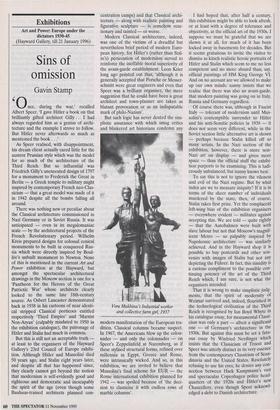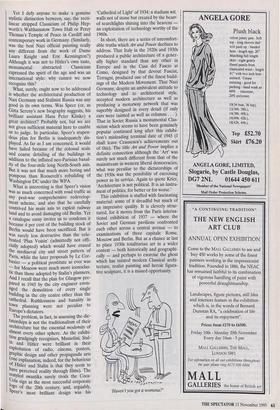Exhibitions
Art and Power: Europe under the dictators 1930-45 (Hayward Gallery, till 21 January 1996)
Sins of omission
Gavin Stamp
Once, during the war,' recalled Albert Speer, 'I gave Hitler a book on that brilliantly gifted architect Gully . . . I had always regarded him as a genius of archi- tecture and the example I strove to follow. But Hitler never afterwards so much as mentioned the book . . .'
As Speer realised, with disappointment, his dream client actually cared little for the austere Prussian style which was the model for so much of the architecture of the Third Reich. But so influential was Friedrich Gilly's unexecuted design of 1797 for a monument to Frederick the Great in Berlin — a Greek temple to military might inspired by contemporary French neo-Clas- sicism — that a great model was made of it in 1942 despite all the bombs falling all around.
There was nothing new or peculiar about the Classical architecture commissioned in Nazi Germany or in Soviet Russia. It was anticipated — even in its megalomaniac scale — by the architectural projects of the French Revolutionary period. Wilhelm Kreis prepared designs for colossal conical monuments to be built in conquered Rus- sia which were directly inspired by Boul- lee's unbuilt monument to Newton. None of this is mentioned in the current Art and Power exhibition at the Hayward, but amongst the spectacular architectural drawings in the Moscow section is one for a `Pantheon for the Heroes of the Great Patriotic War' whose architects clearly looked to the same late 18th-century source. As Osbert Lancaster demonstrated back in 1938 in his cartoons of near identi- cal stripped Classical porticoes entitled respectively 'Third Empire' and 'Marxist Non-Aryan' (culpably misdated to 1950 in the exhibition catalogue), the patronage of Hitler and Stalin had much in common.
But this is still not an acceptable truth at least to the organisers of the Hayward Gallery's 23rd Council of Europe exhibi- tion. Although Hitler and Mussolini died 50 years ago, and Stalin eight years later, and despite all that has happened since, they clearly cannot get beyond the notion that modernism is self-evidently good and righteous and democratic and inescapably the spirit of the age (even though some Bauhaus-trained architects planned con- centration camps) and that Classical archi- tecture — along with realistic painting and figurative sculpture — is somehow reac- tionary and tainted — or worse.
Modern Classical architecture, indeed, was one of the victims of a dreadful but nevertheless brief period of modern Euro- pean history, for Hitler's (rather than Stal- in's) persecution of modernism served to reinforce the ineffable moral superiority of the avant-garde establishment. Leon Krier long ago pointed out that, 'although it is generally accepted that Porsche or Messer- schmitt were great engineers and even that Speer was a brilliant organiser, the mere suggestion that he could have been a great architect and town-planner are taken as blatant provocation or as an indisputable mark of philo-Nazism'.
But such logic has never dented the sim- plistic assurance with which smug critics and blinkered art historians condemn any Vera Mukhina's Industrial worker and collective farm girl, 1937 modem manifestation of the European tra- dition. Classical columns became suspect. In 1967, the Americans blew up the colon- nades — and only the colonnades — on Speer's Zeppelinfeld at Nuremberg, as if these stylised structural forms, refined over millennia in Egypt, Greece and Rome, were intrinsically wicked. And so, in this exhibition, we are invited to believe that Mussolini's final scheme for EUR — the Rome international exhibition planned for 1942 — was spoiled because of 'the deci- sion to classicise it with endless rows of marble columns'. I had hoped that, after half a century, this exhibition might be able to look afresh, or at least with a degree of tolerance and objectivity, at the official art of the 1930s. I suppose we must be grateful that we are shown it at all, for much of it has been locked away in basements for decades. But it seems gratuitous to invite the visitor to dismiss as kitsch realistic heroic portraits of Hitler and Stalin which seem to me no less competent and no more absurd than, say, official paintings of HM King George VI. And on no account are we allowed to make up our own minds: nanny insists that we realise that there was also an avant-garde, that modern painting was going on in Italy, Russia and Germany regardless.
Of course there was, although in Fascist Italy — tolerant of modernism until Mus- solini's contemptible surrender to Hitler and his anti-Semitic policies in 1938 — it does not seem very different, while in the Soviet section little alternative art is shown — perhaps because Stalin killed off so many artists. In the Nazi section of the exhibition, however, there is more non- Nazi art on display — and given more space — than the official stuff the exhibi- tion purports to be examining. This is ludi- crously unbalanced, but nanny knows best.
To say this is not to ignore the vileness and evil of the Nazi regime. But by what index are we to measure iniquity? If it is in terms of the sheer number of individuals murdered by the state, then, of course, Stalin takes first prize. Yet the complacent left-wing bias of the exhibition organisers — everywhere evident — militates against accepting this. We are told — quite rightly — that the Autobahnen were built with slave labour but not that Moscow's magnif- icent Metro — so palpably inspired by Napoleonic architecture — was similarly achieved. And in the Hayward shop it is possible to buy postcards and other sou- venirs with images of Stalin but not any depicting the Fiihrer. In fact, this timidity is a curious compliment to the possible con- tinuing potency of the art of the Third Reich which, I am sure, is not what the organisers intended.
That it is wrong to make simplistic judg- ments, that the spirit of modernity of Weimar survived and, indeed, flourished in the technological civilisation of the Third Reich is recognised by Ian Boyd Whyte in his catalogue essay, for monumental Classi- cism was only a part — albeit a significant one — of Germany's architecture in the 1930s. But against this must be set a fatu- ous essay by Winfried Nerdinger which insists that the Classicism of Troost and Speer was utterly distinct in its very essence from the contemporary Classicism of Scan- dinavia and the United States. Resolutely refusing to use his eyes, he denies any con- nection between Hack Kampmann's and spectacular Copenhagen police head- quarters of the 1920s and Hitler's new Chancellery, even though Speer acknowl- edged a .debt to Danish architecture. vast Yet I defy anyone to make a genuine stylistic distinction between, say, the recti- linear stripped Classicism of Philip Hep- worth's Walthamstow Town Hall or Percy Thomas's Temple of Peace in Cardiff and contemporary work in Germany. (Similarly, was the best Nazi official painting really any different from the work of Dame Laura Knight and Eric Kennington?) Although it was not to Hitler's own taste, monumental abstracted Classicism expressed the spirit of the age and was an International style: why cannot we now recognise this?
What, surely, ought now to be addressed is whether the architectural production of Nazi Germany and Stalinist Russia was any good in its own terms. Was Speer (or, as Gitta Sereny's new biography suggests, his brilliant assistant Hans Peter Klinke) a great architect? Probably not, but we are not given sufficient material here to enable us to judge. In particular, Speer's stupen- dous plan for Berlin is inadequately dis- played. As far as I am concerned, it would have failed because of the colossal scale and coarse detailing of the buildings in addition to the inflated neo-Parisian banal- ity of the four-mile long North-South axis. But it was not that much more boring and Pompous than Roosevelt's rebuilding of Washington DC under the WPA.
What is interesting is that Speer's vision was as much concerned with road traffic as any post-war comprehensive redevelop- ment scheme, and also that he carefully contrived his main axis to exploit railway land and to avoid damaging old Berlin. Yet a catalogue essay invites us to condemn it because 4 per cent of the building stock of Berlin would have been sacrificed. But it was surely less destructive than the cele- brated 'Plan Voisin' (admittedly not offi- cially adopted) which would have erased the mediaeval city and street pattern of Paris, while the later proposals by Le Cor- busier — a political prostitute as ever was for Moscow were much more iconoclas- tic than those adopted by Stalin's planners. And I recall that the plan for Glasgow pre- pared in 1945 by the city engineer envis- aged the demolition of every single building in the city centre other than the cathedral. Ruthlessness and banality in Europe's planning were not peculiar to turope's dictators. The problem, in fact, in assessing the dic- tatorships is not the traditionalism of their architecture but the essential modernity of almost every other sphere. As the exhibi- tion grudgingly recognises, Mussolini, Stal- in and Hitler were brilliant in their exploitation of radio, cinema, posters, graphic design and other propaganda arts (one explanation, indeed, for the behaviour ,13f Hitler and Stalin is that they seem to have perceived reality through films). The restyled swastika surely rivals the Coca- Cola sign as the most successful corp 1orate Speer's of the 20th century, and, arguably, aPeer's most brilliant design was his `Cathedral of Light' of 1934: a stadium wit. walls not of stone but created by the beam of searchlights shining into the heavens an exploitation of technology worthy of the 1960s.
In short, there are a series of uncomfort- able truths which Art and Power declines to address. That Italy in the 1920s and 1930s produced a public architecture of a gener- ally higher standard than any other in Europe and in the Casa del Fascio at Como, designed by that devout Fascist, Terragni, produced one of the finest build- ings of the Modern Movement. That Nazi Germany, despite an ambivalent attitude to technology and to architectural style, accepted modern architecture as well as producing a motorway network that was superbly designed in every detail (if only cars were tainted as well as columns . . . ). That in Soviet Russia a monumental Clas- sicism which seems to have been genuinely popular continued long after this exhibi- tion's misleading terminal date of 1945 (I shall leave Ceausescu's achievements out of this). The title Art and Power implies a definite connection although the 'Art' was surely not much different from that of the mainstream in western liberal democracies; what was peculiar to the dictatorships of the 1930s was the possibility of exercising power in its service. Again to quote Krier, `Architecture is not political. It is an instru- ment of politics, for better or for worse.' This exhibition is stuffed with fascinating material: some of it dreadful but much of an impressive quality. It is cleverly struc- tured, for it moves from the Paris interna- tional exhibition of 1937 — where the Soviet and German pavilions confronted each other across a central avenue — to examinations of three capitals: Rome, Moscow and Berlin. But as a chance at last to place 1930s totalitarian art in a wider context — both historically and geographi- cally — and perhaps to exorcise the ghost which has tainted modern Classical archi- tecture, realist painting and heroic figura- tive sculpture, it is a missed opportunity.
Haven't you got a womenu?'



















































































 Previous page
Previous page